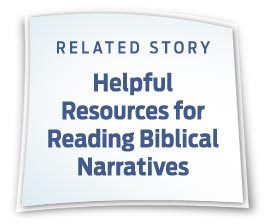
Stories are powerful communicators.
Small talk ebbs away when somebody begins telling a compelling story. Children forget to wiggle—and listen. A church pays attention when a gripping children’s story is told.
Stories reflect our lives and help us connect and identify with heroes or abhor villains that we have never met. They are great teaching tools. (Remember the beloved college professor or high school teacher who told stories in his or her class?)
Scripture is full of stories. Much of the Old Testament and (to a lesser degree) the New Testament is written in story form.1 The story of Jesus is included four times in the New Testament (even though the gospel genre has particular characteristics distinct from general narratives). Jesus Himself was a master storyteller. His preaching of the kingdom of God was interspersed with stories that His audience could relate to—they were current, often surprising, engaging, and at times controversial. With such an abundance of stories in Scripture it is worth our while to understand their makeup and to read with understanding.
 Understanding the Form
Understanding the Form
My eldest daughter is an avid reader (and that’s an understatement). After she has raced through another book, I sometimes ask her about the story line. Typically she can tell me the gist of the story, even though she may not remember all the details.
When it comes to biblical narrative, we often read like her for the big picture. And since Bible stories are so often well known, we may not pay particular attention to all the details. Unfortunately, by doing so we often overlook the literary artistry and beauty of biblical narratives and miss cues that help us understand the story better. Biblical authors did not just sit down and write (or fumble at a keyboard). Awed by the great task of communicating God’s will and purpose for His people, they must have carefully planned their words. Some of them were well educated—remember Isaiah, a member of the royal family, whose literary mastery is quite obvious, even in English. God called others from more mundane occupations and family backgrounds. They all lived in a world in which storytelling was an art and highly appreciated. A world without newspapers and the Internet was full of storytellers who kept their audiences spellbound.
Plotting—and More
Plot is the foundation of any story. A plot is a succession of events that guides the reader to a conclusion. It is the road, at times curvy and mountainous, that finally leads to the destination. Consider this simple plot: Israel is about to enter and take possession of the Promised Land—one-dimensional and fairly straightforward. However, the biblical narrative is much more complicated and multidimensional. Spies check out the land (for a second time); they intersect with the prostitute Rahab, whose destiny becomes intertwined with the destiny of God’s people. While following the narrative of the first chapters of Joshua, the Bible reader learns that military success depends not on military prowess but rather on faithfulness to the God who promised the land.2 Here is an important lesson to be learned: God is part of the plot in Scripture. As a matter of fact, He is the one behind the scenes that often prepares the way and opens or closes doors. Biblical authors felt no qualm including Him in their stories: they knew that He was not far removed. Modern readers may have more trouble with this as they have managed to purge the divine from everyday life.
Show Some Character
Characters of a narrative are closely connected to the plot of the story. As readers we observe and assess, often unconsciously, the character. Do we like her? Can we understand his actions? Are the motives visible? The character is controlled by the narrator. Some characters are “flat,” meaning that they do not appear to be very complex and do not represent the main protagonist, who needs to be watched.
There is a good example of a flat character in Elisha’s story in 2 Kings 6. A nameless Syrian king has sent a powerful expedition force to apprehend the prophet Elisha. When the nameless servant of Elisha gets up in the morning to get water and prepare food for his master, he is terrified by what he sees. “What shall we do?” (verse 15) is his most important line. Following that exclamation, he does not reappear in the narrative. Elisha, on the other hand, represents a “round” (or multidimensional) character. He is not only identified by name, but also takes the initiative and drives the plot to a surprising end. No, the divinely blinded Syrian soldiers are not to be massacred by the nameless king of Israel. Instead, they are given a feast and then sent home. Through repeated prayer, Elisha interacts with the divine protagonist of the story, integrating Him into the plot. Because we are exposed to so much visual stimulation, modern readers often overlook important details that can be gleaned from the text about the character(s). We need to read the text very closely and pay attention.
Setting the Stage
Stories happen in time and space. They involve geography, time lines, and cultural realities that were quite different from ours. Boaz convenes his legal case in the city gate and not at home or in the office of his attorney (Ruth 4). He acts within the context of Israelite (and Semitic) culture. Everybody knew that the gate area was the most public place of a town or city—except most modern readers. Just search in a concordance or on your computer for references to gates and note the important things happening there. What comes next in the narrative, however, is more puzzling: the (nameless) relative who is not willing to marry Ruth takes off his sandal and hands it to Boaz (Ruth 4:7, 8). Can you see the picture? Most of us would be stunned and confused if that happened to us. However, in Boaz’s time it was an accepted symbolic act that carried clear legal implications: I renounce my right to this—it’s now yours.3
 Point of View
Point of View
Drivers know the importance of perspective and point of view. A look in the rearview mirror quickly tells us if we can pass or not. However, any mirror is deceptive. Many car mirrors have the following warning engraved in them: “Objects in mirror are closer than they appear.” In stories, similar to driving a car, the point of view is extremely important and intimately linked to the narrator who tells the story. When we read a story, we need to become aware of the point (or points) of view. The narrator provides important information—or sometimes withholds it from the reader. By including himself in the narrative, the storyteller becomes part of the narrative. Nehemiah refers to “we” in his confessional prayer (Neh. 1:7)—he is part of the story of postexilic Israel. Often narrators include hints to other, earlier stories to help the reader understand a particular situation. Moab in Ruth 1 is not just a value-free vacation spot, but its presence calls up other, mostly negative, references that reflect the point of view of the narrative. It’s a bad place that no Israelite should visit, nor move to. Just think of the story of Lot and his daughters (Gen. 19) and the sin of Baal-Peor (Num. 25).
At times Scripture includes statements that evaluate a given situation: “Now the people of Sodom were wicked and were sinning greatly against the Lord” (Gen. 13:13). This point of view or commentary is designed to provide the reader with additional information to help choose sides.
Keep on Reading
Reading biblical narrative is a good exercise in paying attention. Stories are often condensed, details can be partly hidden, and information may require further cultural or historical background to be appropriately understood. Understanding the function of plot, character(s), setting, and point of view are good steps for reading God’s Word more closely. Generally, words are not chosen randomly, and repetition is often a great guide to see the particular focus or objective of the narrative.
So why take the time and effort to understand the form, plot, characters, and point(s) of view in biblical stories? I have noticed that paying attention to all these elements has enriched my Bible study and has required me to spend more time with Scripture. This is good news in a day and age that is marked by the shortening of our concentration spans—and our time with the Word of God. It has not only provided new insights and food for thought but has also heightened my appreciation for the biblical authors and their capacities to communicate.
Why not let the plot of your life be rearranged as you let yourself be drawn into the great story of God’s Word?
____________
1 See D. N. Fewell and D. M. Gunn, “Narrative, Hebrew,” in Anchor Bible Dictionary, ed. D. N. Freedman (New York: Doubleday, 1992), vol. 4, p. 1023.
2 The Ai episode highlights this concept forcefully. Because of the sin of Achan, Israel is beaten by the inhabitants of Ai and cannot replicate the great victory at Jericho (Joshua 7). It is a powerful reminder by the biblical author that military victory is closely linked to faithfulness to God.
3 Scripture contains many symbolic acts that appear strange to us. See the helpful discussion of the sandal-handover in Åke Viberg, Symbols of Law: A Contextual Analysis of Legal Symbolic Acts in the Old Testament, ConBOT 34 (Stockholm: Almqvist and Wiksell, 1992), pp. 145-165.
__________________
Gerald A. Klingbeil is an associate editor of the Adventist Review who is riveted by scripture’s stories—especially the story of salvation. This article was published August 18, 2011.